For those travelers around the world seeking a truly exotic, not-so-mainstream Asian cultural and historical adventure, there is one site lurking around the corner, among those big names of the glorious East Asian culture, the mysterious Angkor Wat, and the tranquility of the Taj Mahal. I’m talking about the My Son temples! Hop on an adventure, accompanied by local buddies from Onetrip to get to know these mysterious temples!
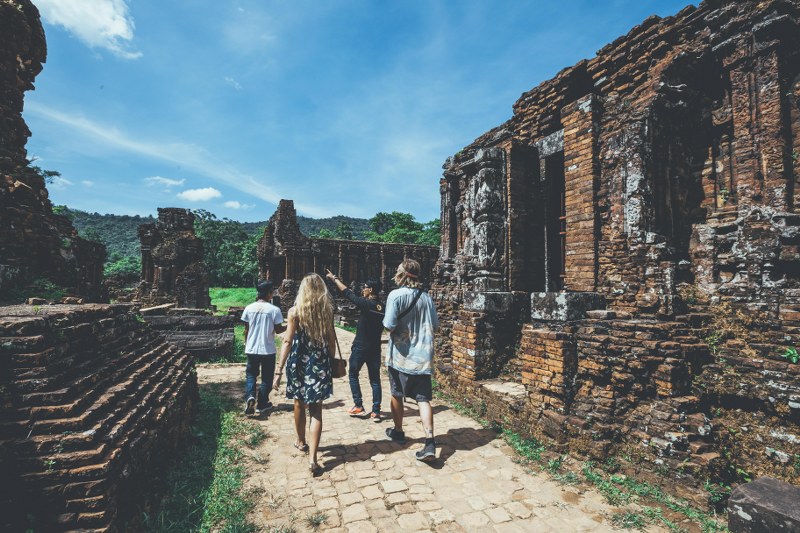
Contents
History of the My Son Sanctuary
Located in the very center of the world map provides Vietnam with the advantage of having one of the most multicultural environments in the world.
With seas of silver and jungles of gold and a very accessible location, the country has attracted many people wanting to settle in this promised land, and also those who wanted to colonize the territory for their own good. Those who have come and gone, left little bits of themselves, the wars, the culture, and the cuisine that forms the place we call Vietnam today.
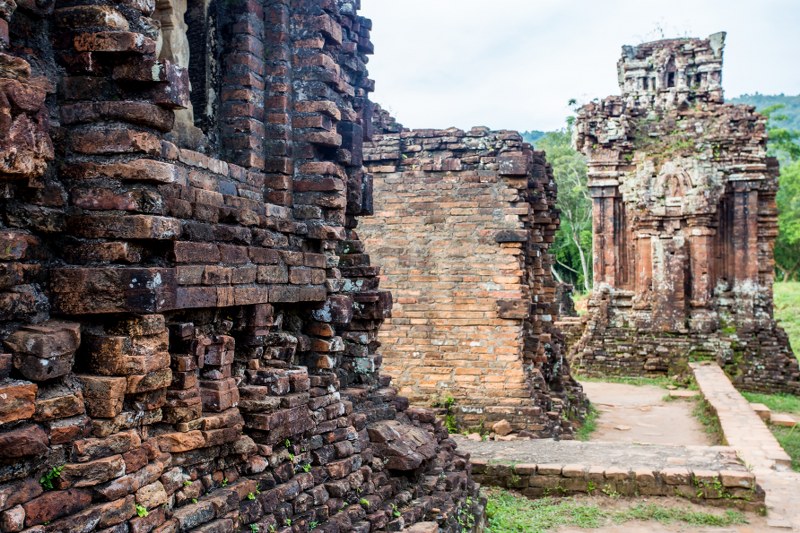
Stories to tell, soil to walk, and a destination to come. Onetrip is willing to take you on a motorbike time machine, guiding you through the very best of Vietnam’s history, culture, and food with a local friend by your side. Our highlighted historical and cultural trip of the day is the Onetrip’s My Son Adventure, riding against the current of time, from the breezy Ancient Town of Hoi An, through the bumpy tracks between the green fields, heading to a place that time has not touched for 1,600 years, the My Son Sanctuary of the ancient Champa Kingdom.
The My Son Sanctuary (mee-sern) is located in the Quang Nam region (kwang-nam) which has retained many tangible traces of history. The region has hosted the Champa kingdom of master craftsmen and sea traders from the second century until 1832. There, the capital Indrapura and its port Champapura (nowadays Hoi An) played a vital role in the maritime Silk Road from seventh to the tenth century, exporting tusks, ivories, spices, and silk, and therefore adopted social, cultural, and political exchanges as well.
At that time here in this region, three cultures melted in one pot: the Viet, the Khmer of the Nagas, and the Champa that originated from the Borneo Island of what is called Indonesia today. When the kingdom fell under the Conquer of Dai Viet Empire in 1471, the site was abandoned for centuries until the French discovery in 1885. My Son Sanctuary was inscribed in the UNESCO World Heritage List in 1999.
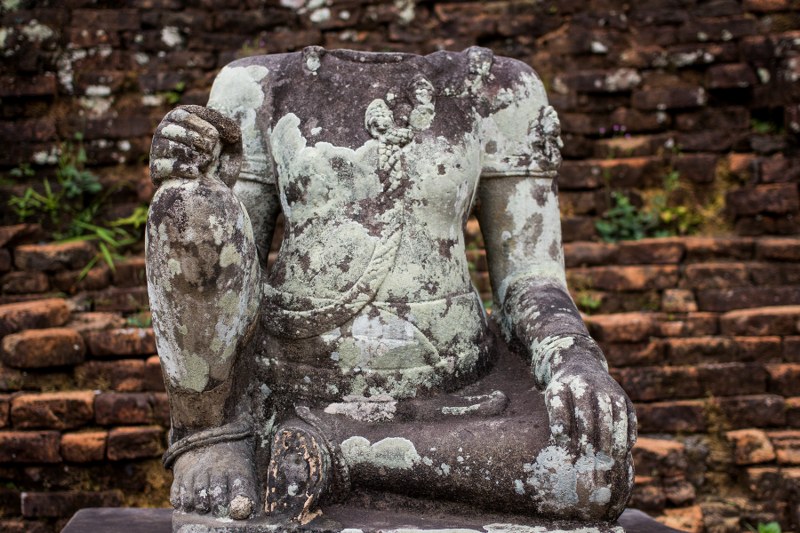
Your My Son adventure with Onetrip starts early in the morning – around 7 AM. Your departure point is the Joi Kitchen & Bar restaurant located in Christina’s Hoi An riverside resort, and here you will have a quick bite, a lovely cup of phin-filter coffee, and of course, get your formalities out of the way. When everyone is ready and you guys have become the best of friends, then it is time to get on the motorcycle and head to the tranquil old town of Hoi An.
Tranquil morning in the alluring Hoi An Ancient Town
Hoi An was the former commercial capital of the Cham from the seventh century until the kingdom was conquered by Dai Viet Empire in 1471. Not until the year of 1595, was the town brought back to life and flourished again as an important trading center of the later Lê Dynasty. Since Hoi An was considered as the best destination for trading in all of Asia during its time, it hosted large Chinese and Japanese communities, as well as Portuguese, Dutch, and Indian people. Moreover, the port town became a major trading hub between Europe, China, India, and Japan, and goods were traded to as far as Sinai, Egypt.
However, Hoi An was badly plundered in the Trinh – Nguyen conflict in 1775, and every trading facility was destroyed. Not even a single trace of the Japanese settlement was left, apart from the Japanese Bridge. The town that we see nowadays is only the reconstruction by the effort of returning Chinese and Vietnamese traders after the war. Da Nang then became the new trading center backed by the French, and Hoi An has remained forgotten, untouched by the flow of history for 200 years, holding memories of a once bustling port.
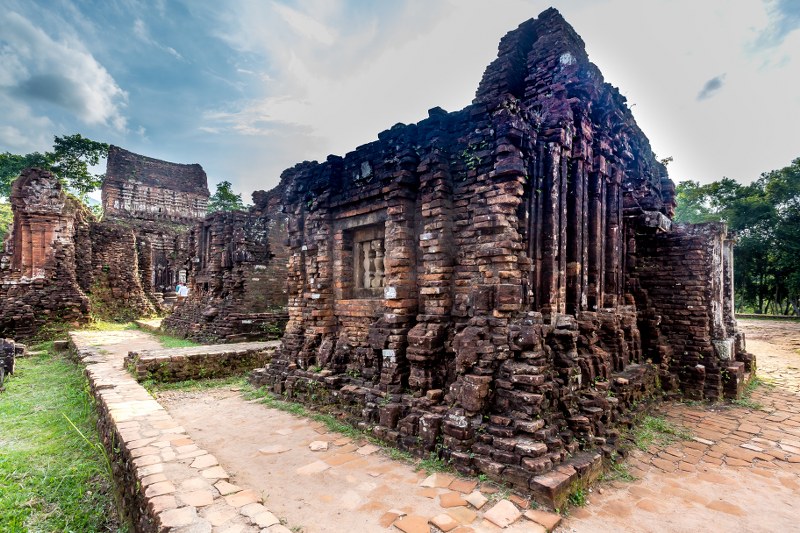
Riding towards the old town, any tiredness you feel will be no more as the fresh morning breeze will certainly wake you up. You will drive past the Tra Que vegetable village, the first organic vegetable village in Vietnam. Here, all the veggies and herbs served in dishes throughout Hoi An are grown, chemical free.
Unfortunately, there is no time to stop, but if you would like to learn more and experience a farming and fishing adventure sometime, click here! Take in the fresh breeze, feel the warmth of sun rays lurking in the foliage, hear the joy of local chatter over street coffee as you ride through the streets. It’s certainly a ride that will wake up those senses! But this is only the beginning – it will only get better from here.
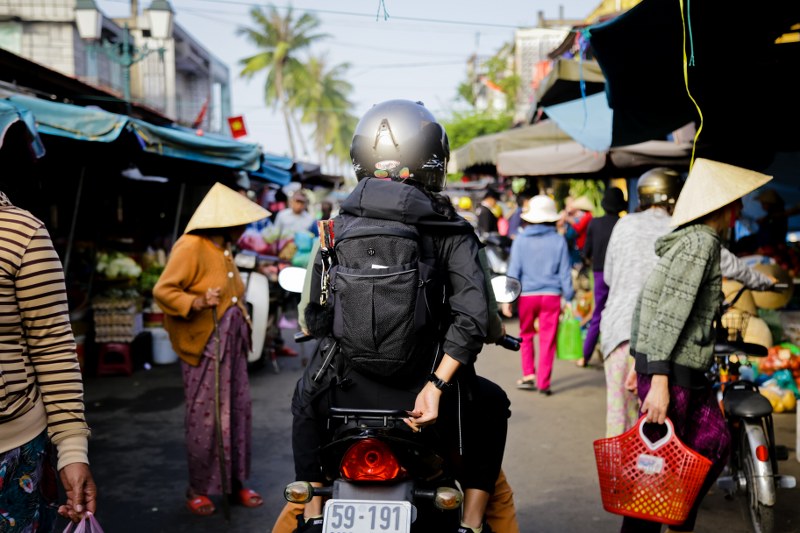
After wandering around the town for a while, you and your new friend will take a quick stroll around a local Hoi An market. Here, you will have a chance to stock up for the journey – some fresh fruits, local specialties, and some souvenirs if you wish. The market is lively at this hour, so make sure to snap some pictures. Once you have all you need, it’s time to hop on a ferry and leave Hoi An behind. An expedition to an enchanting land is about to begin.
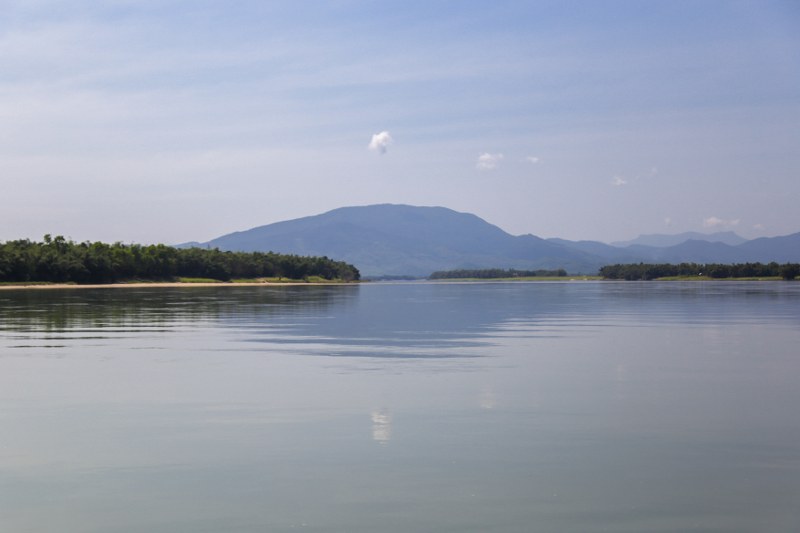
The wooden boat will take you to Kim Bồng carpentry and boat building village that dates back to the 15th century. Stories about the fathers who built the port town and its vessels that traversed the world over hundreds of years ago, are about to unfold. In fact, Kim Bong village contributed to building the Imperial City of Hue and the tomb of Ho Chi Minh, and not only those but their ancestors built trading vessels and warships for the Spanish Navy 400 years ago. You’ll be able to watch these craftsmen in action, doing what they do best, using skills passed down through generations. And then it’s time to hop back on the bike again and head out.
Hundreds of years of traditional mat-weaving
After you pass through paddy fields with happy grazing cattle and water buffalos, you will soon arrive at your next stop – a traditional mat-weaving village. Even though nowadays we Vietnamese sleep on fluffy mattresses and elevated beds like everyone else in the world, straw mats still play an important role in our culture, spiritual life, and more than that, our childhood with heart-warming fairy tales from our grandparents.
When I was younger, I used to sleep on a straw mat spread out on the floor. My family used to eat around a big round tray on a straw mat as well. On hot summer nights, my grandma would put a mat on the rooftop, and my friends and I would gather around that, listening to old stories while the light breeze would slowly rock us to sleep. Shows and plays at the village hall back in the day couldn’t take place without straw mats, because those were our seats. Straw mats were not only used by ordinary folk, but also the royal family as well! The village that you will visit has been weaving mats for the Nguyễn Emperors and national festivals for hundreds of years, so there must be interesting tales and stories for you to listen to.
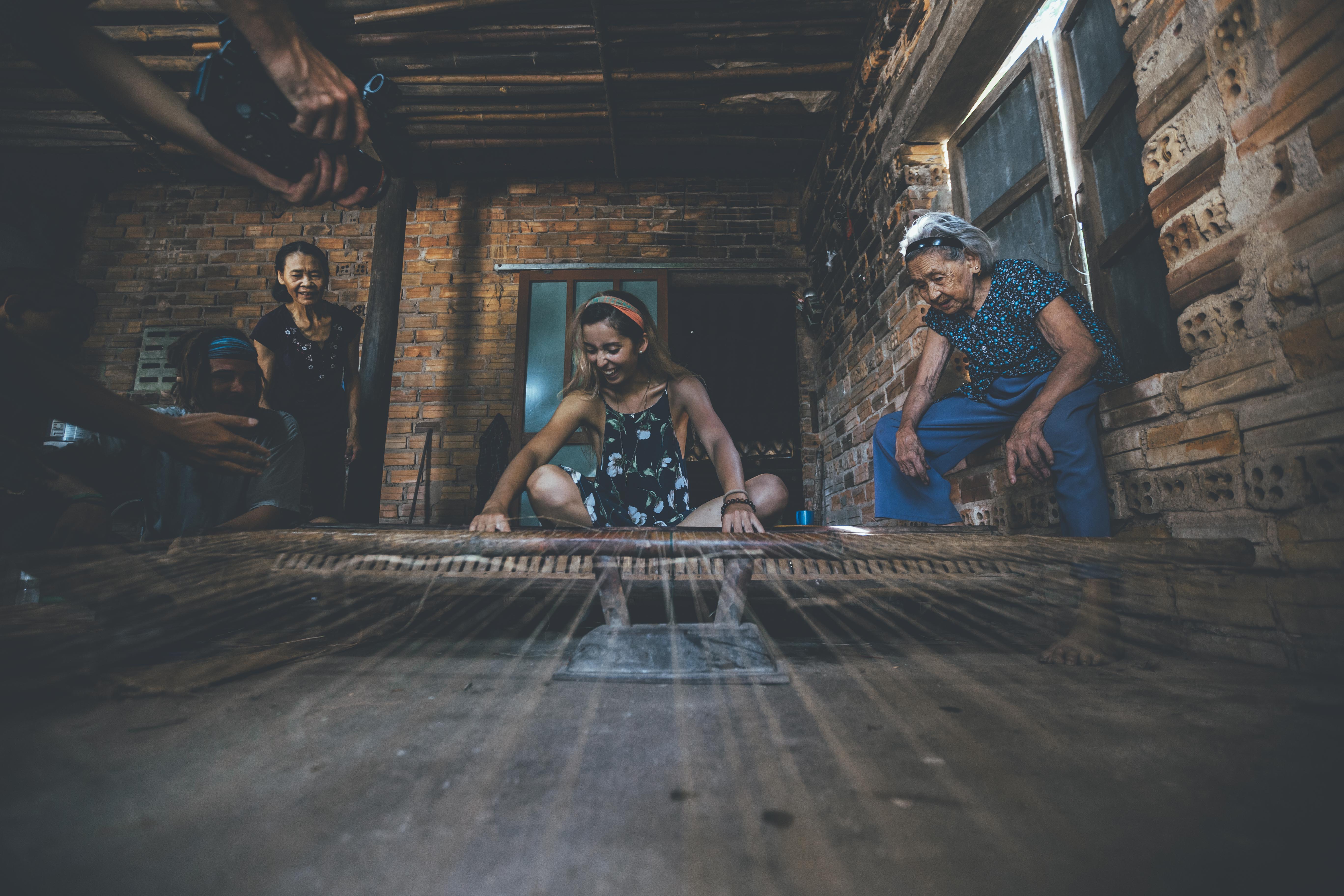
You will get to spend some time at a 96-year-old master weaver’s factory to learn about the crafting process of an excellent mat and actually you will get to experience weaving one yourself! It is not a hard chore at all, because even an elder lady in her 90s can do it. But please don’t get too excited and craft a beautiful piece of art, the lady needs a successor and she’s will keep you there forever if you show promise. While you are busy weaving, your guide and the lady will also share with you some facts about the local life and some Vietnamese traditional culture as well, so there are a lot of things to keep you on your toes at all times. Just to remind you, the mats produced there are top-notch quality, it stays warm in the winter and chill during the hot days with a pleasant natural fragrance. I recommend getting one for your family, for either household purposes or my personal favorite, beach time.
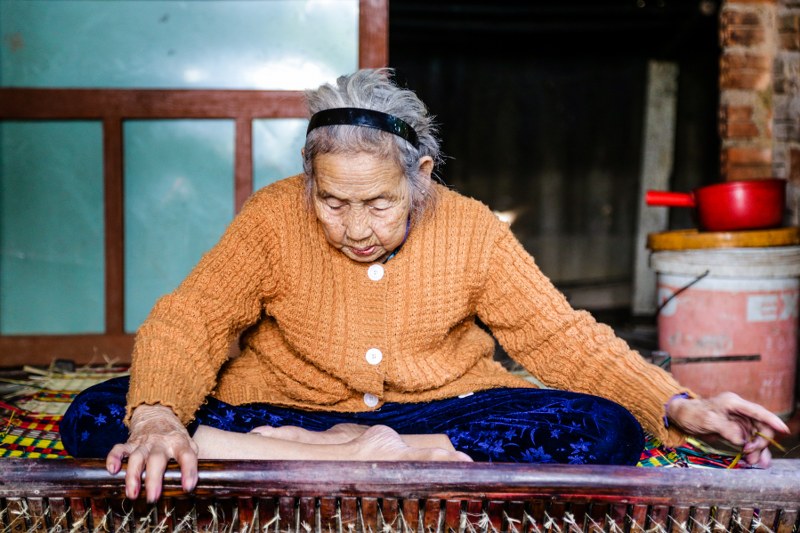
When you are ready to be back on the tracks, we will grab some water and say goodbye to the lovely lady, and head to the next fascinating facility – the handicraft bronze-casting village.
Artistic creations from the remnants of more than one war
The handicraft bronze-casting village was founded in the Southern expedition epoch of the Nguyen Lords, approximately 400 years ago. At that time, the village served as an armory for the military forces, manufacturing mainly weapons, statues and ritual instruments like incense, bells, and gongs. The occupation has passed down through 17 generations and the village still retains the same traditions, but now their products are mainly used for cultural and festive purposes. Years of war and battles have passed, and nowadays the village carries a more humane mission, transforming bullet cases and bombshells into beautiful creations that cherish culture and emanate peace. From the destructive remains of the Vietnam War, the masters create meditation bells, flower vases, statues, and other meaningful pieces of art.
Apart from their skillful hands, they are also masters in metallurgy – in other words, metal blending. But that’s not all, these masters also have a knack for sound perception which makes them particularly good at building musical instruments for Central Highland folk. Crafted from the blazing fire and smashing hammers, with the perfect combination of materials, sounds from their gongs are powerful, echoing for miles across the jungles and hills, yet clear and heartfelt, resembling the soulful heart of the men living up high in the mountains. You would feel the heat, the sweat, and how much effort and patience these bronze-smiths put into their respected creations.
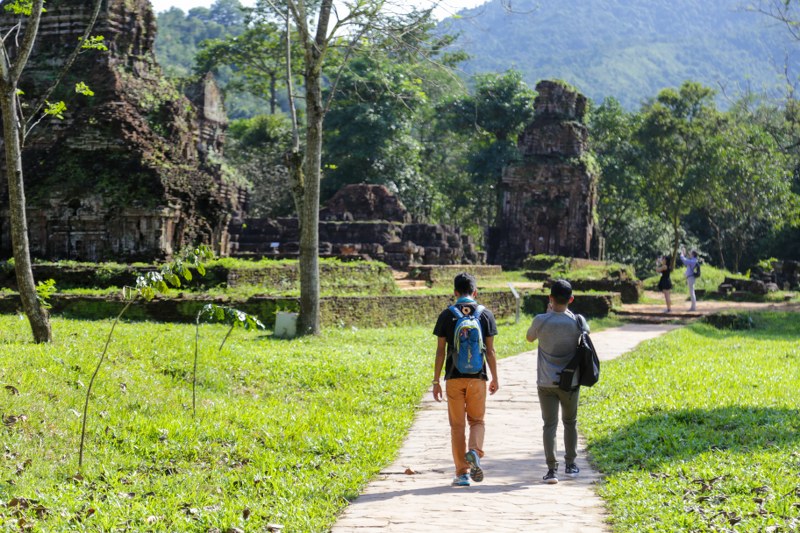
Moving on from the forge, you will take a short walk to the place that has changed Vietnam’s history and development since being built in 1617. It is the second Catholic church ever built in Vietnam – the first one was constructed in Hoi An in 1615. It witnessed the birth of the modern Vietnamese writing system, by priest Francisco de Pina from Portugal, and later fully developed and published by Alexander de Rhodes from France. Even though the majority of people believe that the Vietnamese alphabet is based on French letters, Portuguese is actually the closest resemblance as a matter of fact. The romanization of the Vietnamese language has made it way easier to learn since the old base of the language was Chinese characters. It has helped to eliminate illiteracy across the country and creates endless possibilities for the Vietnamese to learn Western languages, fostering foreign trade to this day.
Around noon you will hit the road again and head directly to My Son Sanctuary. Can’t believe you’ve been on the road since the morning, huh? Around this time it gets hot and muggy, so why not get a chilled coconut and a cup of ice-cold sugarcane juice under the shade? These are also must-haves during your time in tropical Vietnam – a good way to relieve the heat, rehydrate your body, and the natural sugar content of these juices will keep you energized all the day.
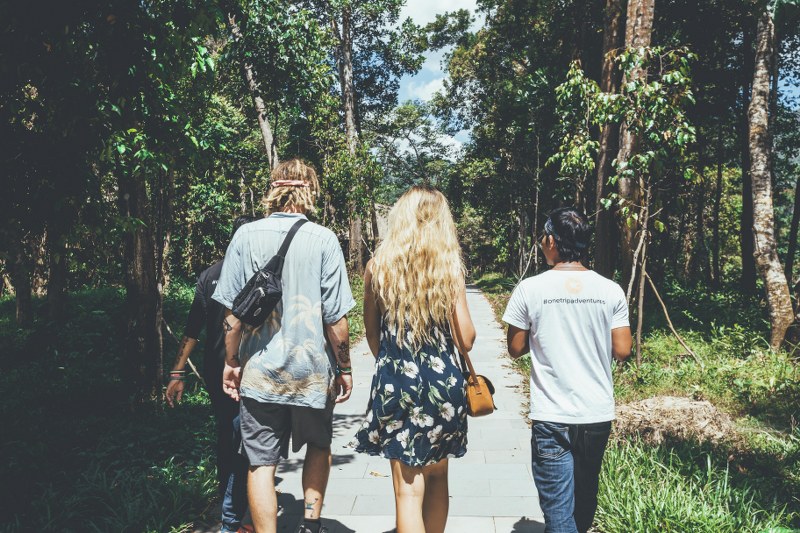
There is still a long bumpy road to ride and I am pretty sure that the group is now a little hungry. Being well-fed is highly important for an adventure. How about joining a local family’s hearty lunch? And on the way there, you will be able to savor the beautiful landscape of Vietnam’s countryside as well, akin to a delicious appetizer. After sitting down with a local family and enjoying a delicious authentic family-style lunch, our desired destination – the My Son Sanctuary – is now only just a couple of miles away.
My Son Sanctuary – The Land that Time Forgot
Being one of the most historically influential peoples among the 54 diverse ethnicities of Vietnam, the Champa’s heritage is also the most time-enduring, still standing magnificently on top of the hills, commemorating a glorious empire. My Son Sanctuary is the biggest Champa architecture complex in the country, sited in a blessed and isolated location, inside a two-kilometer diameter basin surrounded by mountains and jungles like a natural fortress. Therefore, the sanctuary was meant for kings and high priests only, where communication with the Gods of Hinduism was made.
Even though the capital of the Champa Empire has moved many times, from Simhapura – in Quang Nam province (fun fact: the name means Lion City – same as Singapore), to Indrapura – near Da Nang, Vijaya – Bình Định province, and lastly Panduranga – Phan Rang province, My Son Sanctuary still remains as the heart of Champa’s religion and culture.
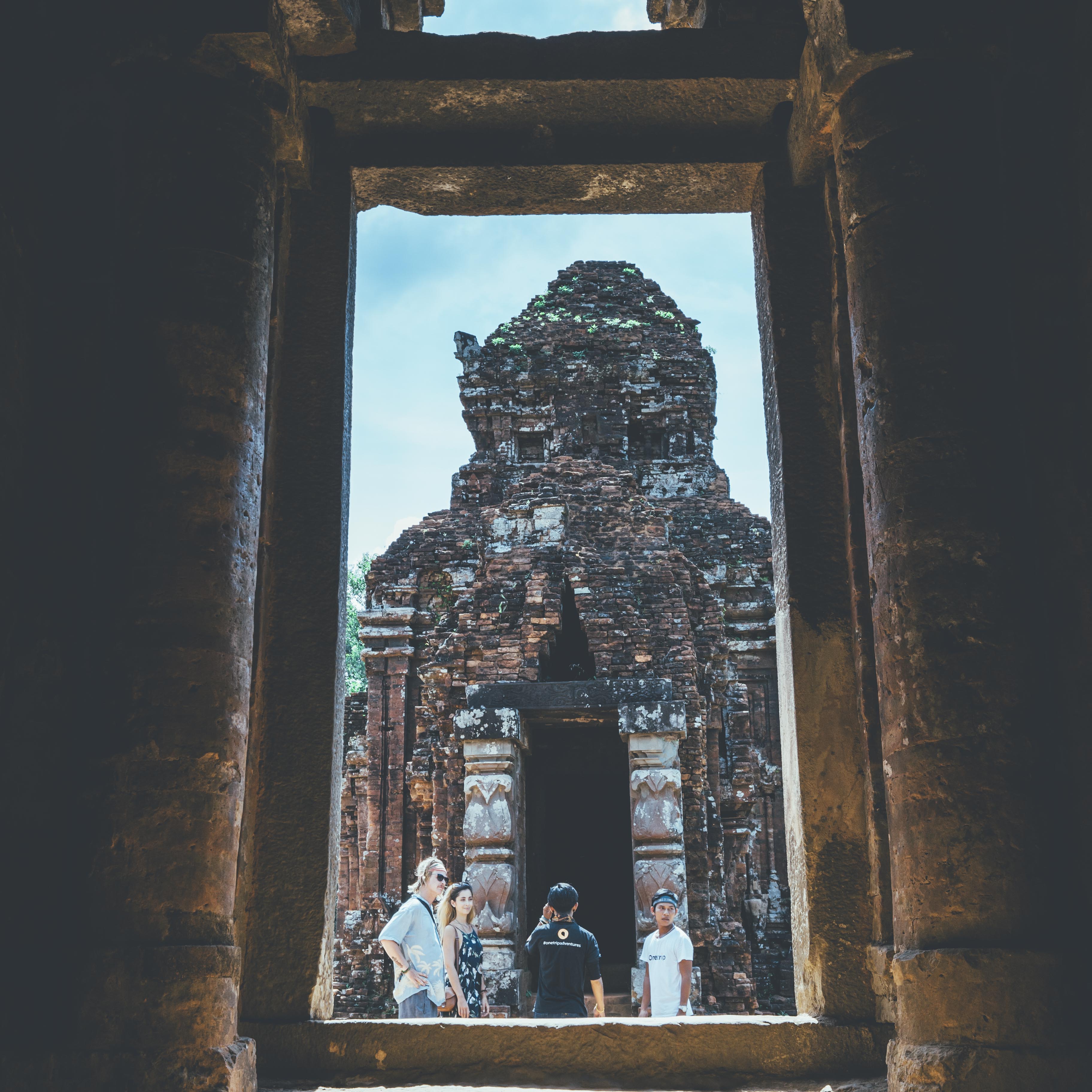
Kazimierz Kwiatkowski, the Polish architect who contributed the most to the restoration of My Son Sanctuary in the 1980s, once said: “The old Champa people have harmonized their soul with soil and stone, connected themselves to the mother of nature and built a mighty, magnificent and eternal lasting My Son. This is also a monumental museum of humanity, archiving invaluable knowledge of long-forgotten culture, sculpture, and architecture surpassing our understanding for hundreds of years to come”. That’s a fact. The temples and towers of the sanctuary are full of mysteries that still riddle historians and specialists. These buildings have reached perfection and withstood the harsh trial of time.
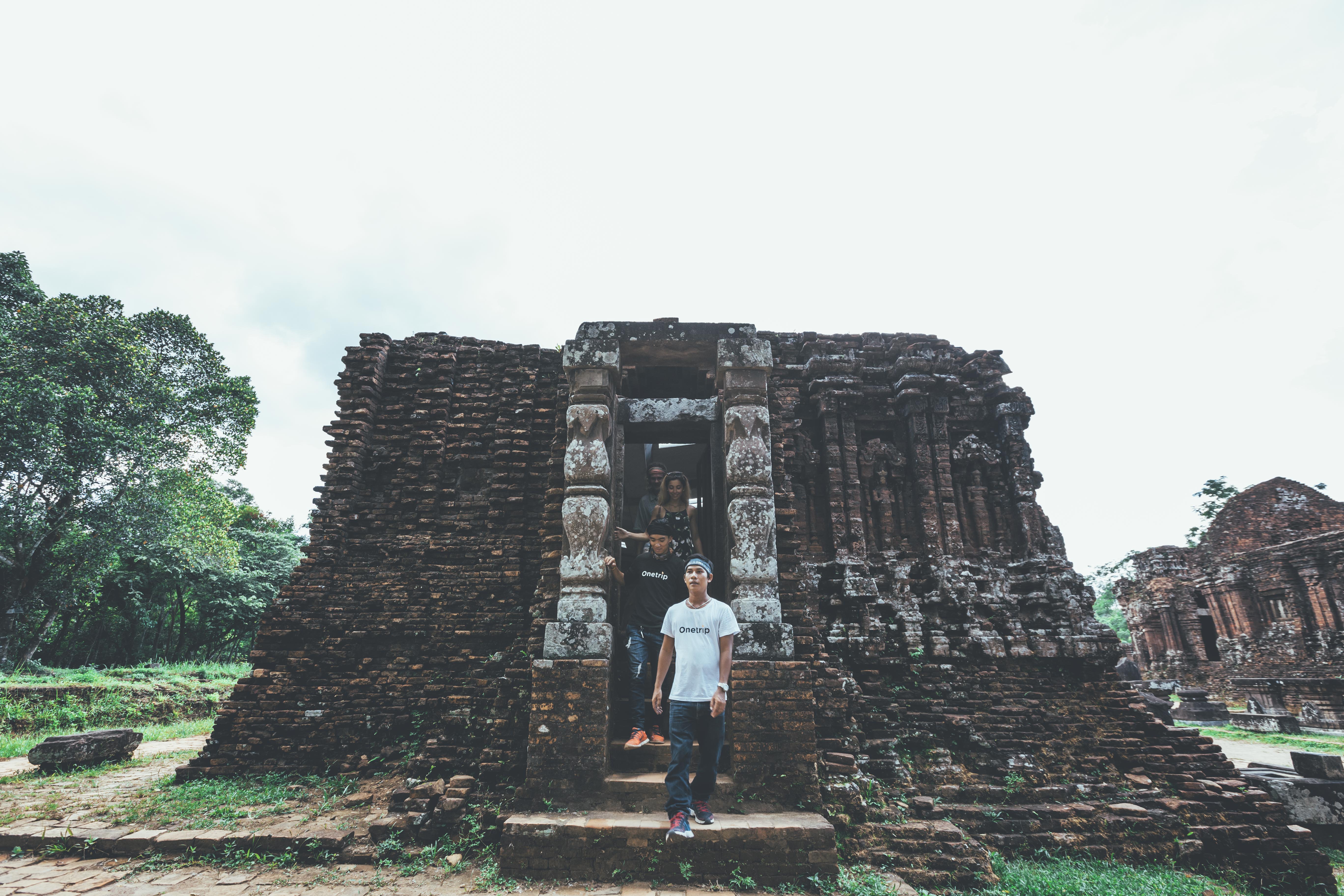
The temples were built with baked bricks and sandstone. Every piece of material is attached without mortar or concrete, but instead, it adheres with an unidentified organic glue. Excavations show that the sculptures were chiseled directly into the building after the construction was completed. Normally, this would cause the structure to be fragile and easily weatherable, but due to their secret brick-baking technique and a special coating, the exteriors of the temples are still intact since the eighth century.
The statues, the scripts on the steles, and the images of the reliefs are still clear and lively, bringing their stories and messages to the future, from as early as the fourth century. Bear in mind, this was way before the famous Angkor Wat in Seim Reap, Cambodia. Furthermore, the whole complex was built gradually over a period of 1,000 years, with more than 70 towers, one after another and each of them carries their own unique features of their eras.
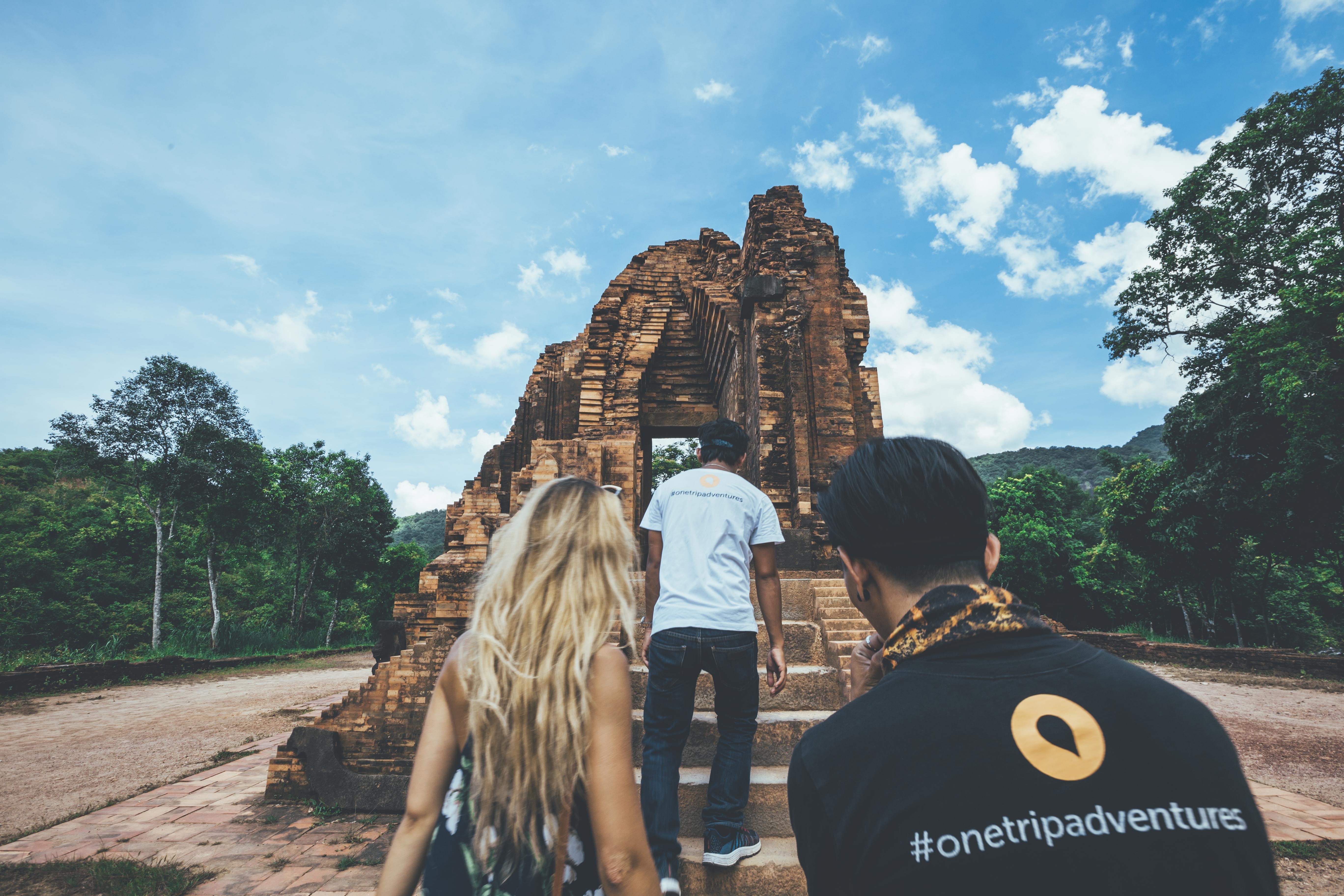
The first and most influential culture of the My Son Sanctuary is Ancient Hinduism, which can be seen from the depictions of Indian dancers, mythical gods and creatures, and especially the Linga – Yoni statues (male and female genitals). Even the landscape represents Linga and Yoni. Upon arrival, you will notice a rather phallic temple rising to the sky, in the middle of a female-like sacred valley, literally. The combination of Linga and Yoni is one of the basic ideologies of Hinduism. It stands for creation, growth, and prosperity.
In addition to Indian cultural highlights, there are many temples that have influences from Khmer, Indonesian, and Northern Vietnamese cultures as well, depending on the era they were constructed. It feels like you are experiencing an all-inclusive package of Asian ancient cultures in one place, which truly is worth the long ride. And by chance, you could also watch the local Cham performers present their traditional dance and folklore. Through the glamorous and velvety dance, the rustic yet alluring melody, the dancers express their pursuit of a merry and peaceful eternity for their people and the whole of humanity that has been carried over thousands of years…
Going back, to the future
Before concluding the adventure, there is one last thing to see at the sanctuary: the cruel destruction of war. Upon the discovery of the My Son Sanctuary in 1898, there were 72 towers and temples galore. The excavations were ceased during the Indochina Wars in the 20th century and the complex fell into oblivion again, until the 1980s. 50 towers were destroyed in the fiercest period of the Vietnam War, from 1969 to 1972, due to the heavy bombing of Quang Nam province.
The ruins were then cleared during the restoration process, but the remnants of war still remain. You will see craters of explosions, the empty foundations of many once ever-lasting towers, and the scattering of bombshells. As a matter of fact, there are still a lot of lurking unexploded bombs in the region that have caused tragedies to once happy families. Endless efforts have been made to continue to restore My Son Sanctuary and recover the lingering torment from the war that happened 40 years ago.
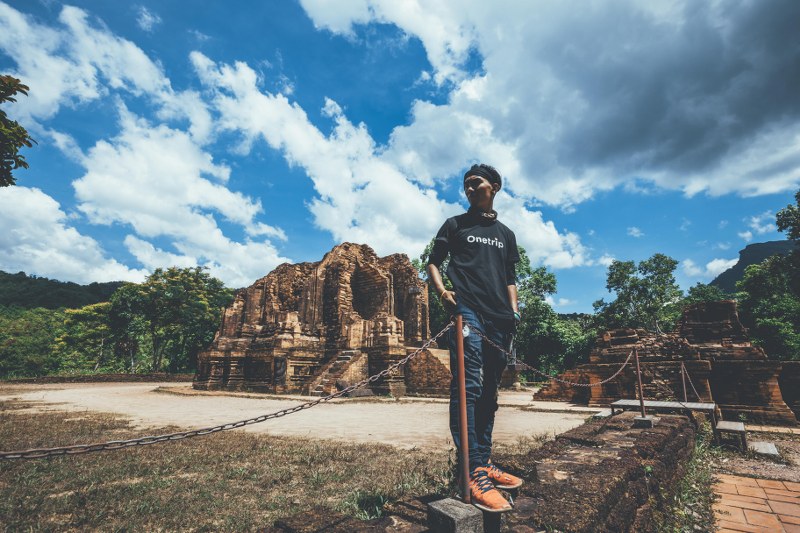
The trip is not just history or about the things that still remain in this very moment either. Take a moment to cherish your memories of today, thrive to learn, and be eager to go and see. Everything happened for a reason, every piece of faraway history contributes to the world that we are living in. With your tourist shoes on, get moving, and enjoy every bit of unknown stories about an unfamiliar people from this distant country.
So, ready to join Onetrip in going back a thousand years? Hit us up on our website, onetrip, if you have any questions or are ready to go on this journey with us. More information is, of course, available on the website, and you can also check out what our previous guests have to say on our TripAdvisor page.
Price:
– On motorbike: 85 USD/pax
– Private car: 135 USD/pax
– Shared minivan: 65 USD/pax
Dresscode: Because this is a sacred area, please wear clothing that covers your shoulders, stomach, and knees.
